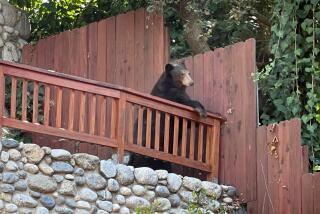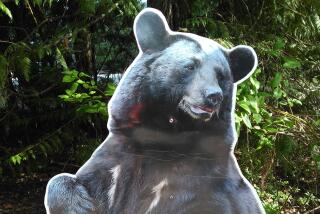The Real Bear Has a Sharp Bite
- Share via
I love gummi bears. Not just any gummi bears--most are like super-strength Jell-O with a taste reminiscent of sweetened pencil erasers. No, mine are the true bears, the original Gold Bears from Haribo.
What makes these candy bruins so special are their texture, flavor and consistency. Unlike chewing gum and local gummi varieties, the Haribo bears have a fruity taste that lasts until the final piece dissolves in your mouth, so you’re not left with a tasteless wad that you have to swallow or spit out. And where other bears are Jell-O-soft and gooey, Haribo bears resist chewing with a tenacity not found in domestic gummi candy. There’s a sense of conquest that appeals to the hunter long dormant in all of us. You can feel good about it too, because no animals are actually harmed in this pursuit of chewing pleasure.
Like most gummi candies, the Gold Bears contain corn syrup, sugar, gelatin and cornstarch, so they can be considered a source of proteins and carbohydrates, simple and complex. And they have no fat. So not only are Haribo gummi bears good for you, these fruity, chewable, multicolored grizzlies may also really be a kind of super-food--one that bites back.
Or am I just rationalizing?
Regardless, gummi bears have been around for generations and will probably be around a good while longer.
Conceived in the early 1920s by Hans Riegel of Bonn as the Tanzbar (“Dancing Bear”), the gummi bear was an immediate hit. Riegel would make as many as 100 kilograms of the sweets every day, and his wife, Gertrud, would deliver them on the company bicycle. Ultimately this load became too great for her, and Haribo (an acronym for HAns RIegel BOnn) purchased a car for deliveries. It was in 1946, however, during the postwar economic recovery or Wirtschaftswunder, that business really took off.
The bears have evolved over the years and, like a lot of us, are now more squat than they were 70 years ago. But they are still immensely popular. Haribo has 12 factories in Europe and produces 70 million gummi bears daily. World domination through candy may not be a company goal, but the bears eaten annually in Germany alone would circle the globe about three times--standing up.
Colonization of the United States began in 1982 with the founding of Haribo of America. But in the 14 years that the company has had a base here, Haribo has captured only about 30% of the market. Not that there is a shortage; there are no immigration quotas for candy creatures. The problem is more one of demand. American gummi consumers seem to reach for the cheaper products.
“Most of the time we don’t even get tasted,” says Margie Walter, a sales representative of Haribo of America, “just because of the price.”
Gummi connoisseurs (or kenner)--like myself--know what that extra cost will buy, but most Americans have not caught on.
Haribo has even altered American gummi bears, brightening the colors for more visual appeal.
“The Germans don’t use any artificial ingredients or colors in the European bears,” Walter says, “but because the colors are a bit paler, the Americans think they’re old. Our products where the colors aren’t as bright have bombed here.”
The company has also experimented with softer textured bears because of American complaints that the product was too firm. After enormous negative response from Haribo loyalists, however, the company reverted to the characteristic sturdy gummis. The taste and texture of the candies are not the problem. The problem, it seems to me, is familiarity, which is where I come in.
More than 10 years ago, in college, a German exchange student in my class offered me my first taste of these ursine sweets, and I was immediately smitten. I initially misinterpreted the feelings as a crush on the coed, but my infatuation with my friend soon came to an end, while my feelings for the candy remained constant. There have been boom and bust years since then, from feast in Berlin to famine in Los Angeles, but there’s always been that same excitement. And because of this unique personal relationship with Haribo gummi bears, I have taken upon myself the mantle of gummi evangelist. It’s not gospel, but they taste pretty darn good.
I have been able to find--though they are not widely distributed--regular gummi bears, sugar-free gummi bears, gummi rattlesnakes (klapperschlangen), various gummi fruits, and some half marshmallow and licorice candies. But regular gummi bears--in pear, lemon, cherry, lime and orange flavors--are Haribo’s biggest sellers. It’s not just me. There are plenty of people out there with a sharp, sweet tooth.
Bears have been sighted at Alpine Village in Torrance and other German markets, as well as at some Thrifty’s, but there are not many of them. My only request is that you leave some for me.
More to Read
Eat your way across L.A.
Get our weekly Tasting Notes newsletter for reviews, news and more.
You may occasionally receive promotional content from the Los Angeles Times.










